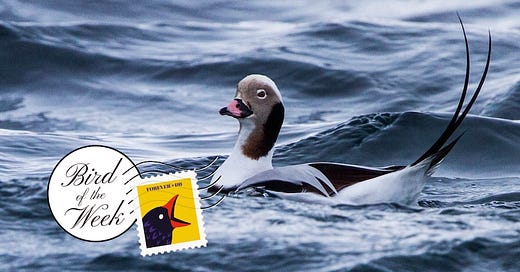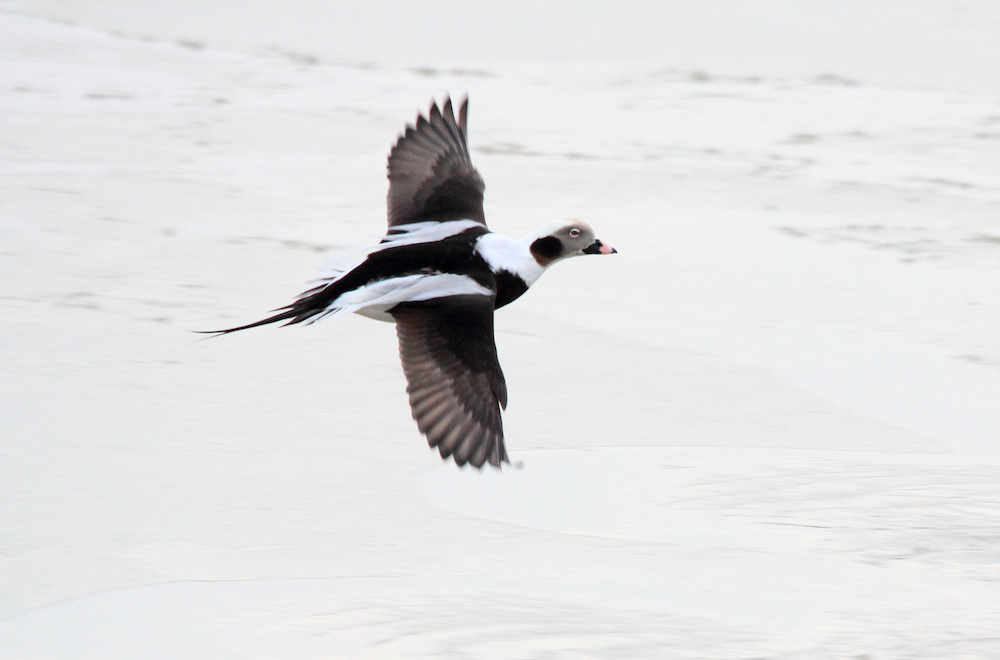Sometimes, the bird world makes it easy for us here at Bird of the Week. Take this week’s duck—the third in our Duck Month miniseries.
This duck is called….the long-tailed duck. It’s a duck. It has a long tail. What more needs to be said?
OK, moving on, this has been Bird of the We—
OH MY GOD HOLD THE FREAKING PHONE. IT’S A DUCK. AND IT’S GOT A LONG TAIL. LOOK!!!! DUCK!!!! TAIL!!!!!!!!!! TAIL! DUCK!!!!
Also the jaunty little multicolored bill!!!!
And the snowy white feathers on top of its head like it’s an old-timey news anchor! Hey, is that an actually good-at-his-job version of Wolf Blitzer I’m looking at??? No. It’s something better: a long-tailed duck.
Holy cannoli. This DUCK.
OK, I’m done hyperventilating. Sort of. Before I go on, I should just give a shoutout to Elias Markee-Ratner, a New York-area bird expert and photographer who suggested this duck for us to feature. (This is why the birding community matters so much to Bird of the Week: because I am a bird idiot who needs smart people like Elias to steer me in the right bird direction.) A most excellent choice!
Let’s get into some quick long-tailed duck facts.
Their tail feathers really are long—up to six inches! They are used by the male ducks to attract the female ducks.
If you want to see them, you have to wear some layers, because long-tailed ducks live in very cold places—from the north of Canada and Alaska into the Arctic, over to Greenland and across the north of Scandinavia and Siberia. When your teeth are chattering and you’re seeing more ice floes than usual, that’s when you know you’re in Duck Town.
They used to have a racist name I will not repeat here. Now they are called long-tailed ducks. Crazy thought: when you’re naming an animal and your first idea is “what if I imported racism into the world of ducks,” maybe keep brainstorming.
If you noticed that the ducks look a little different in some of the pictures above, that’s because they dramatically change their plumage from summer to winter. In summer, they’re that more brownish shade that you can see in the second picture. In winter, they’re a dramatic black and white.
They are a harbinger of better days to come. From the Whitefish Point Bird Observatory in Michigan: “To the Inuit of Nunavut, the arrival of the Long-tailed Duck (or in their language, aggiarjuk) heralds spring’s coming. Traditional songs exalt the event–‘When we have survived the worst and the future looks promising, the Long-tailed Ducks have now returned. As they return, they are full of joyous spirit.’”
They are master divers. In fact, no other diving duck spends as much time underwater as a long-tailed duck. When other ducks are like “boy, it might be time to go back up to the air,” a long-tailed duck is like “are you KIDDING me I am staying down here.” According to this video, when they’re foraging for food, they spend 3-4 times as much time underwater as they do above it, and they can dive almost 200 feet down to get the seafood they love to munch on. For some reason, the video points out that this is a longer distance than the length of things such as the Challenger space shuttle or Big Ben. Good to know, I guess?
They are loud as hell—way louder than ducks usually are.
Add that all together, and what do you get? You get an iconic duck. Let’s watch some videos.
Here’s a cool slow-motion one of all these ducks diving in unison. (They also like to travel in big groups, that’s another fact.)
(Said slowly) Wwwwwooooooooooooooooowwwwwwwwwwwwww.
Here’s a video where you can hear their very loud call. Apparently it inspired the Cree nickname for them: Ha-hah-way. You will definitely be able to tell why.
Here is a video of them flying around. The music is annoying but the footage is not.
And, finally, here is a very soothing video of the ducks just swimming around.
Aren’t we lucky to be in a world with long-tailed ducks?
A reminder: you can check out our complete Bird of the Week list here, and get in touch with your bird suggestions at hello@discourseblog.com.









If you thought "I wanna see the duck underwater"
https://youtu.be/EvdVrt89EHY
Long-tailed ducks are fantastic. You can see whole rafts of them off the coast of the northeast US in the winter. I'd argue they are one of the ducks whose males in non-breeding plumage (like in the top photo, sporting the full white top of the head) are even more striking that the males in breeding plumage (like the second photo if the whole top of the head was dark).
It's been years since I've heard of this happening, but I have multiple friends who have had the unfortunate experience of a (usually older white male) birder deciding to strike up a conversation with them while observing long-tailed ducks by opening with, "You know, they used to call them [racist name]...". Yet another data point in why the Bird Names for Birds folks are so rad.
Off to look at gulls tomorrow morning! Fingers crossed we'll get some ducks as well.